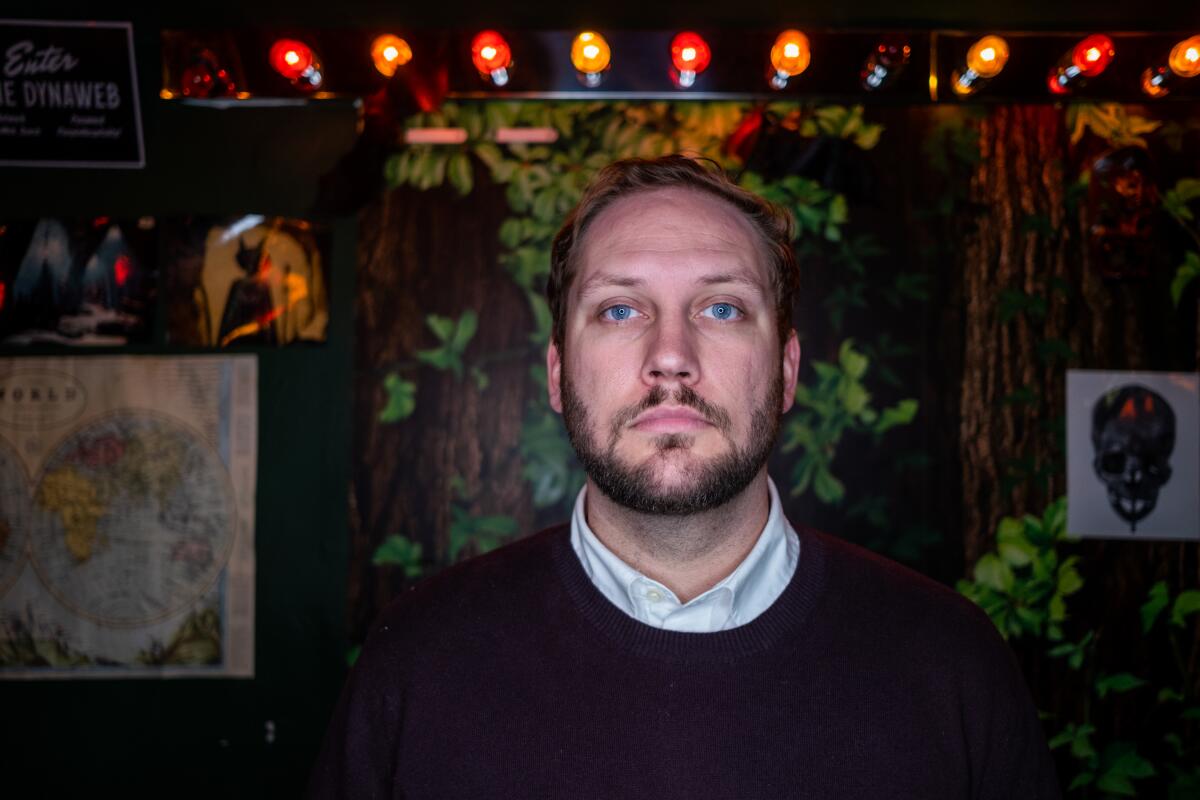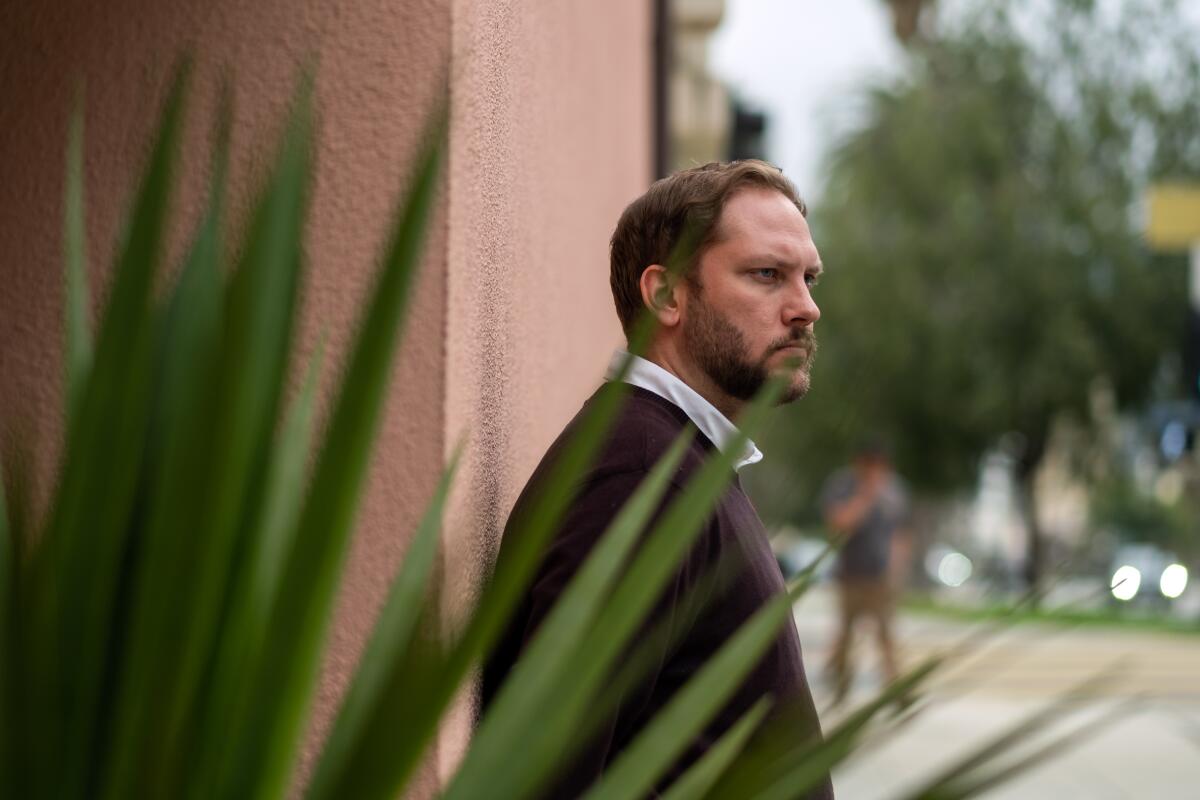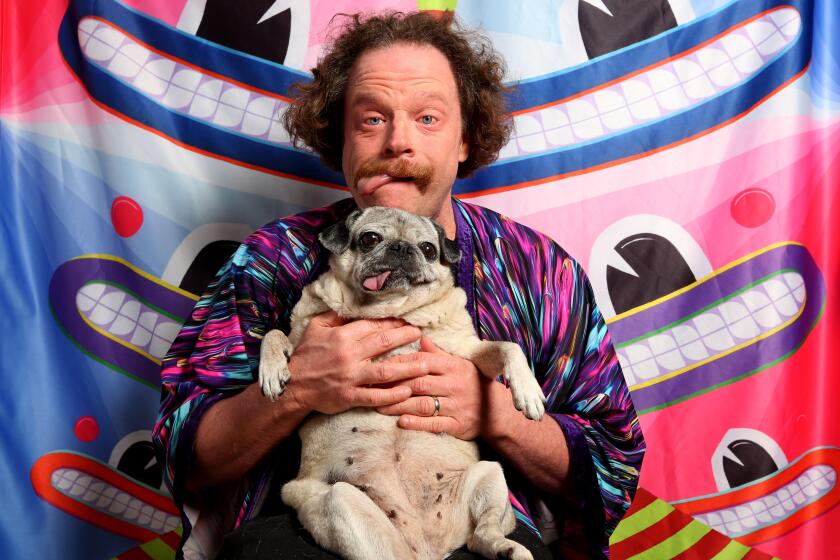Comedian Kyle Ayers navigates a chronic pain disorder onstage and off

- Share via
The audience has ignored numerous flash flooding warnings to be at Silver Lake’s 75-capacity Lyric Hyperion theater on a recent rainy evening. Up top, host Kyle Ayers thanks them for braving the torrential downpour and introduces them to “Boast Rattle,” a head-to-head compliment-based take on “Roast Battle.” But unlike its Comedy Store counterpart, the stand-up comics going head to head are trying to comically build each other up instead of lobbing insults.
Crowd members can vote up to two times per person for each round and winning names get added to a championship bout to battle for the Belt of Flowers. The show is, as Ayers describes it, “ironic comedy.” It’s also only the second in-person L.A. production that the host, who’s performed on “Conan,” SiriusXM and Comedy Central, has put up since venues reopened post-COVID.
Before kicking “Boast Rattle” off, Ayers pauses to set a complimentary mood: “I’m gonna get into the Boasting spirit and talk to you guys about a brain disease I have called trigeminal neuralgia,” he begins. “It’s like a nerve exploded at the base of my brainstem. And there’s a lot of negative about it, but I was trying to think of the good parts of having a degenerative brain disease …”
He unveils a keynote presentation called “Kyle Boasts His TN,” immediately diving in deep. “It’s called Suicide Disease!” Ayers shares. “It might sound like a negative. But it’s only called that because it has the highest rate of suicide of any medical ailment!” Others include “I was dead for 10 minutes!” “Cool scars!” and “I win chronic-pain support groups!”
By the second round of “Boast Rattle,” Ayers sits onstage right next to guest judge Guy Branum. While contestants Brent Weinbach and Johnny Pemberton continue complimenting each other, Ayers’ jaw works up and down and side to side, he massages the right side of his head, his eyebrows raise in pain. After the show, he can barely talk. Tonight was the first time he’s addressed his TN onstage, and he’s happy with how it went.
“It was amazing to see the response,” confirms producer Katherine Swope. “It’s easy to write jokes about dating or a bad boss, but it takes a special alchemy to make light of something as dark and serious as his brain condition.”
“We’re here as artists to make light of things that are so heavy,” echoes Ayers’ friend Andy Frasco, frontman of Andy Frasco & the U.N. The two have collaborated on ideas from wrestling-themed band tours to quarantine talk shows. “For him to open up about what he’s been dealing with for years and try to make it into comedy is inspiring, it’s f— ballsy and it makes me proud.”
All of which Ayers appreciates. He’s just not sure he’ll be capable of ever seeing the material to fruition.
Known in the L.A. comedy scene for his storytelling, creative concepts, interactivity and Midwestern sense of vague unease, Ayers discovered his love for stand-up at the Midland Theatre, the Kansas City stop of 2003’s juggernaut Comedy Central Live With Lewis Black and Dave Attell tour. The co-headliners were beloved on “The Daily Show” and “Insomniac,” respectively. But it was opener Mitch Hedberg whom Ayers began quoting with friends.

While attending the University of Missouri, Ayers worked as a reservationist and door guy at the Déjà Vu Comedy Club. He tried his first open mic at 20, using a fake ID to get into a Kansas City bar. Following his set, the host returned to the stage and told Ayers to kill himself. It took about a year for him to try getting back onstage. He started slow, making cracks about Déjà Vu’s drink specials and joining campus improv group Comedy Wars.
After a year in Chicago, taking classes at Second City and ImprovOlympic, Ayers hit the Brooklyn, N.Y., mic scene in 2012. At least he thinks it was 2012. He believes TN affects his sense of time and his memory. Dates are tricky. “It feels like I’m sifting through a filing cabinet, actually processing and buffering, but I can’t recall things like I used to be able to,” he says.
At Brooklyn’s now-defunct Spike Hill, he ran “Game Night, a Comedy Show.” The comedians onstage played everything from Monopoly and Mad Libs to Ultimate Outburst and Family Feud. Soon Union Hall and the Bellhouse hosted new concepts like “Boast Rattle,” “Never Seen It,” (famous films/shows remade by people who’ve never seen them) and “First Comes Love” (comedians acting out Craigslist porn scripts), which started breaking through with industry and fans; MTV filmed a pilot.
Ayers met Frasco while hosting “We Bee Spelling” (a drunken spelling-bee-meets-fundraising event) at the Knitting Factory. Frasco led the house band. Ayers was, Frasco remembers, “always the smartest guy in the room. He’s so witty about creating concepts and brainstorming ideas and being able to execute everything.”
He’d also begun noticing headaches. According to old insurance claims, doctors thought the pain was something dental. Dentists couldn’t find anything but performed extractions regardless. SSRI blocker antidepressants triggered allergic reactions and made him seize up. He couldn’t quit them without ramping down dosages. Ayers still had decent health insurance working for Apple’s Fifth Avenue Genius Bar through 2016, though nothing much helped.
Long comedy sets made him tick and twitch. The pain could make him pass out. Light and wind hurt. At its worst, TN keeps Ayers away from comedy, and from people altogether for months at a time. “It’s just very interruptive,” he says from his home in Atwater Village. “It’s spending a lot of time on the kitchen floor, just keeled over and crying and freaking out.”
By late 2017, Ayers had relocated to Los Angeles and began developing “Boast Rattle” into a series at Nerdmelt Showroom, the Virgil and Dynasty Typewriter. Though he lost the rights to his own show to another comedian, he never failed to impress the industry with his creativity and new inspirations.
“A lot of shows that break away from the traditional format end up feeling like an unnecessary gimmick, but Kyle has managed to create multiple shows that stand completely on their own,” Swope says. “Kyle has always been an incredibly solid joke writer and performer.”
Ayers recorded his debut comedy album “Happiness” outdoors at Echo Park’s Stories bookstore in December 2019 for Bay Area comedy label Blonde Medicine. The evening was rough. He twitched throughout. Afterward, heading toward his car, he vomited in Echo Park Lake.
One doctor’s scan finally found something, but when it was determined to be noncancerous, that was the end of the diagnosis. He was in and out of urgent care constantly. There was well-meaning advice about painkillers, acupuncture, reiki, movement therapies and Ojai specialists.
Ayers continued performing when he could, joining Andy Frasco & the U.N. and tour mates Big Something as special guest announcer on their Royal Rumble tour in February 2020. It ran 29 shows in 30 days, with Ayers often onstage for 30 minutes each night in significant pain.
Frasco recalls witnessing meltdowns and more. “I’ve seen him five minutes before he goes on, crying the pain is so bad … then he wiped the tears off his eyes, took a big breath and put a smile on his face and crushed it. He comes offstage and he’s so weak, but he doesn’t show it onstage. He’s a true professional. It reminds me of Andy Kaufman going through cancer and doing his last shows or Bill Hicks having cancer but still puffing cigs and talking s—.”

Doctors finally entertained the possibility of TN the following November. Ayers was told it‘s a rare disorder occurring mostly in elderly women. As he describes it, an improperly functioning cranial nerve triggers the pain receptors in his brain stem to feel like “I’m getting stabbed and electrocuted at the same time in the right side of my face.” He tightens up to the point where, as he posted on Instagram in February, “I’ll vomit until it’s blood and the blood vessels in my eyes are all popped out.”
Multiple out-of-pocket tests and surgeries, including a procedure for microvascular decompression, only gave Ayers one eight-month period of respite. “I’ve lived with bad pain in my head for a long time, thinking, ‘That’s just how it is,’” he says. “It’s started to get to the point where you are very pessimistic about having a future.”
He’s currently back to where he was before, “in a spot where it’s a lot of shrugging from doctors and surgeons.” They tell Ayers people just learn to live with it. Or, alternately, people don’t. After performing at a 2021 trigeminal neuralgia awareness fundraiser in Chicago, he met people who had been living with TN for 10 or 15 years. He was the youngest person there by far.
Ayers has no fundraising account, but he remains available for hire as a writer or performer. On better days, he explores the beginning bones of a one-person show about TN. Successfully channeling his darkest challenges into positive art would create his most personal and challenging material to date. “You want to find a throughline and something that’s not just like me being sad as s—, talking about sad s— and riffing off of it,” he says. On worse days, however, there’s no point.
“When the pendulum of my mental state swings towards optimistic, I see a show. I think there’s something to it, eventually. But when it swings back the other direction, no. I don’t think I’ll be around when this would be a developed show, if this is life every day.”
More to Read
The biggest entertainment stories
Get our big stories about Hollywood, film, television, music, arts, culture and more right in your inbox as soon as they publish.
You may occasionally receive promotional content from the Los Angeles Times.












